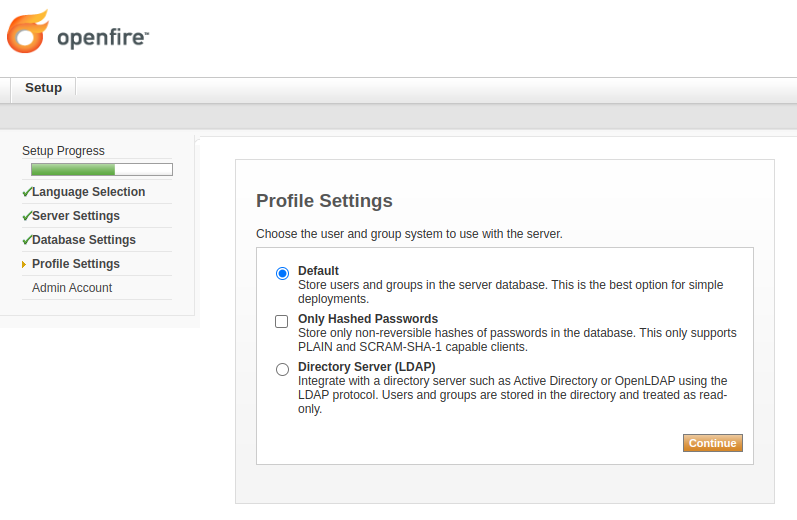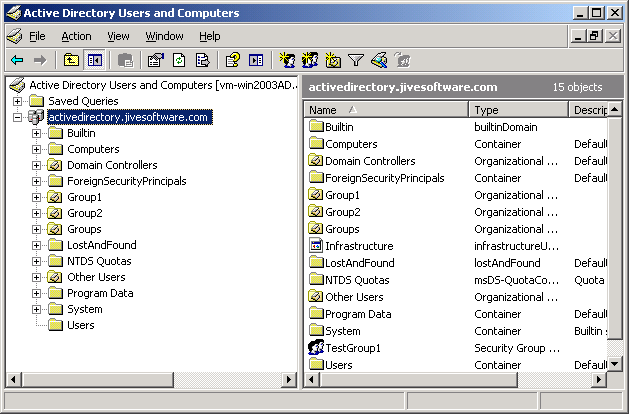LDAP Guide
Introduction
This document details how to configure your Openfire installation to use an external directory such as Open LDAP or Active Directory. Integration with a directory lets users authenticate using their directory username and password. Optionally, you can configure Openfire to load user profile and group information from the directory. Any group in Openfire can be designated as a shared group, which means that you can pre-populate user’s rosters using directory groups.
Background
LDAP (Lightweight Directory Access Protocol) has emerged as a dominant standard for user authentication and for storage of user profile data. It serves as a powerful tool for large organizations (or those organizations integrating many applications) to simplify user management issues. Many LDAP servers are available, such as Open LDAP, Active Directory, and Novell’s eDirectory.
By default, Openfire stores all user data in its database and performs authentication using database lookups. The LDAP module replaces that functionality and allows Openfire to:
- Use a LDAP server to authenticate a user’s identity.
- Load user profile information from a LDAP directory.
- Load group information from an LDAP directory.
Note: Openfire treats the LDAP directory as read-only.
This document will guide you through configuring LDAP support in Openfire. These instructions assume that you’re a competent LDAP user, and that you’re familiar with Openfire setup issues.
Configuration
The Openfire setup tool includes an easy to use LDAP setup wizard. Choose the LDAP option on the Profile Settings page to configure directory integration. The wizard along with in-line help will guide you through the rest of the process. Specific tips for working with Active Directory are noted below.
If you have already completed the setup process but need to enable LDAP integration, you can re-run the setup tool. To do so:
- Stop Openfire.
- Edit conf/openfire.xml in your Openfire installation folder and set true to false .
- Restart Openfire and enter the setup tool.
Working with Active Directory
Microsoft’s Active Directory is a broadly deployed directory system that supports the LDAP protocol. You’ll be prompted for several LDAP fields when connecting to Active Directory servers, some of which are detailed below:
The base DN describes where to load users and groups. If you’re using a default Active Directory setup, all user accounts and groups are located in the «Users» folder under your domain. In LDAP form, that’s cn=Users;dc= . To get more specific, say your domain is activedirectory.jivesoftware.com. In that case, your base DN would be cn=Users;dc=activedirectory,dc=jivesoftware,dc=com. If you’ve customized where users are stored, you’ll just need to replicate that folder structure using LDAP syntax.
By default, Active Directory does not allow anonymous LDAP connections. Therefore, you’ll need to enter the DN of a user that’s allowed to connect to the server and read all user and group data. Unless you’ve created a special user account for this purpose, an easy choice is to use the built-in administrator account. By default, the administrator DN is in the form cn=Administrator,dc= . Using our previous example, cn=Administrator,cn=users,dc=activedirectory,dc=jivesoftware,dc=com.
Manually Editing the Config File
If you prefer to edit the configuration file to enable LDAP integration directly, use the following instructions. Open the configuration file conf/openfire.xml from your Openfire installation in your favorite editor and add or change the following settings. Properties flagged with ( * ) must be set. Properties flagged with ( ** ) must be set in order to enable LDAP group support, all other properties are optional:
The most common usage of a search filter is to limit the entries that are users based on objectClass. For example, a reasonable search filter for a default Active Directory installation is «(objectClass=organizationalPerson)». When combined with the default filter, the actual search executed would be «(&(sAMAccountName=<0>)(objectClass=organizationalPerson))».
ldap.subTreeSearch — by default, Openfire will search the entire LDAP sub-tree (starting at the base DN) when trying to load users. If this property is set to false, then sub-tree searching is disabled and users will only be loaded directly from the base DN. Disabling sub-tree can improve performance, but it will fail to find users if your directory is setup to use sub-folders under the base DN.
- ActiveDirectory: false
The most common usage of a search filter is to limit the entries that are groups based on objectClass. For example, a reasonable search filter for a default Active Directory installation is «(objectClass=group)». When combined with the default filter, the actual search executed would be «(&(cn=<0>)(objectClass=group))».
Below is a sample config file section:
You’ll most likely want to change which usernames are authorized to login to the admin console. By default, only the user with username «admin» is allowed to login. However, you may have different users in your LDAP directory that you’d like to be administrators. The list of authorized usernames is controlled via the admin.authorizedUsernames property. For example, to let the usersnames «joe» and «jane» login to the admin console:
Custom Search Filter
By default, Openfire will load all objects under the baseDN that have the attribute specified by ldap.usernameField. In the case that the username field is set to «uid», the search for all users would be «(uid=*)». However, there are cases when this logic does not work — for example, when a directory contains other objects besides users but all objects share «uid» as a unique identifier field. In that case, you may need to specify a custom search filter using ldap.searchFilter. As an example, a search filter for all users with a «uid» and a «cn» value of «joe» would be:
The «<0>» value in the filter above is a token that should be present in all custom search filters. It will be dynamically replaced with «*» when loading the list of all users or a username when loading a single user.
Some custom search filters may include reserved XML entities such as «&». In that case, you must enter the search filter into the openfire.xml file using CDATA:
Custom Inital Context Factory
Some LDAP servers or application servers may require that a different LDAP initial context factory be used rather than the default (com.sun.jndi.ldap.LdapCtxFactory). You can set a custom initial context factory by adding the following to openfire.xml:
Connection Pooling
The default LDAP provider (Sun’s) support pooling of connections to the LDAP server. Connection pooling can greatly improve performance, especially on systems with high load. Connection pooling is enabled by default, but can be disabled by setting the Jive property ldap.connectionPoolEnabled to false:
Note that if you turn on LDAP debugging, connection pooling will not be enabled. If SSL LDAP mode is enabled, you must set a system property to enable pooling of SSL LDAP connections.
LDAP vCard Integration
The LDAP vCard provider will expose LDAP profile information as vCard data for XMPP clients that support the XMPP vCard extension. First, enable the provider:
Next, you must add mappings between LDAP fields and vCard fields in the openfire.xml file. The vcard attributes are configured by adding an attrs=»attr1,attr2″ attribute to the vcard elements. Arbitrary text can be used for the element values as well as MessageFormat style placeholders for the ldap attributes. For example, if you wanted to map the LDAP attribute displayName to the vcard element FN, the XML snippet would be:
The vCard XML must be escaped in CDATA and must also be well formed. It is the exact XML this provider will send to a client after after stripping attr attributes and populating the placeholders with the data retrieved from LDAP. This system should be flexible enough to handle any client’s vCard format. An example mapping follows.
Источник





